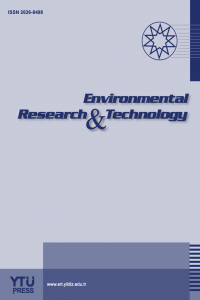Mixing effect on bio-methanation, settleability and dewaterability in the anaerobic digestion of sewage sludge fractions
Mixing effect on bio-methanation, settleability and dewaterability in the anaerobic digestion of sewage sludge fractions
Anaerobic digestion, biosolids, dewaterability, mixing settleability, sewage sludge,
___
- G. Tchobanoglous, F. L. Burton, and H. D. Stensel, “Wastewater engineering: Treatment, disposal and reuse,” (International Ed.), Mc Graw Hill Press, 2003.
- G. Mininni, A. R. Blanch, F. Lucena, and S. Berselli, “EU policy on sewage sludge utilization and perspectives on new approaches of sludge management,” Environmental Science and Pollution Research, Vol. 22, pp. 7361–7374, 2015. [CrossRef]
- B. Wu, X. Dai, and X. Chai, “Critical review on dewatering of sewage sludge: Influential mechanism, conditioning technologies and implications to sludge re-utilizations,” Water Research, Vol. 180, Article 115912, 2020. [CrossRef]
- İ. Öztürk, “Anaerobik arıtma ve uygulamaları,” Su Vakfı Yayınları, 2007. [Turkish]
- M. Kim, Y. H. Ahn, and R. E. Speece, “Comparative process stability and efficiency of anaerobic digestion; mesophilic vs. thermophilic,” Water Research, Vol. 36, pp. 4369–4385, 2002. [CrossRef]
- American Public Health Association, “Standard methods for the examination of water and wastewater,” (21st ed.), American Public Health Association (APHA), American Water Works Association (AWWA) and Water Environment Federation (WEF), 2005.
- D. Erdirencelebi, and M. Kucukhemek, “Diagnosis of the anaerobic reject water effects on WWTP operational characteristics as a precursor of bulking and foaming,” Water Science and Technology, Vol. 71(4), pp. 572579, 2015. [CrossRef]
- P. Winter, and P. Pearce, “Parallel digestion of secondary and primary sludge,” in Proceedings of the 15th European Biosolids and Organic Resources Conference, November, Aqua Enviro, Leeds, UK, 2010.
- C. M. Braguglia, A. Gianico, A. Gallipoli, and G. Mininni, “The impact of sludge pre-treatments on mesophilic and thermophilic anaerobic digestion efficiency: Role of the organic load,” Chemical Engineering Journal, Vol. 270, pp. 362–371, 2015. [CrossRef]
- N. Pinto, A. Carvalho, J. Pacheco, and E. Duarte, “Study of different ratios of primary and waste activated sludges to enhance the methane yield,” Water and Environment Journal, Vol. 30, pp. 203–210, 2016. [CrossRef]
- L. Appels, J. Baeyens, J. Degreve, and R. Dewil, “Principles and potential of the anaerobic digestion of waste-activated sludge,” Progress in Energy Combustion Science, Vol. 34, pp. 755–781, 2008. [CrossRef]
- D. Erdirençelebi, and C. Bayhan, “Feasibility and potential of separate anaerobic digestion of municipal sewage sludge fractions,” Water SA, Vol. 46(1), pp.123130, 2020. [CrossRef]
- D. Erdirençelebi, and G. M. Ebrahimi, “Enhanced sewage sludge treatment via parallel anaerobic digestion at the upper mesophilic level,” Journal of Environmental Management, Vol. 320, Article 115850, 2022. [CrossRef]
- C. F. Forster, “Bound water in sewage sludges and its relationship to sludge surfaces and sludge viscosities,” Journal of Chemical Technology & Biotechnology, Vol. 33B(1), pp. 76–84, 1983. [CrossRef]
- J. Wingender, K. E. Jäger, and H.-C. Flemming, Interaction between extracellular polysaccharides and enzymes, In: J. Wingender, T. R. Neu (Eds.), “Microbial Extracellular Polymeric Substances,” pp. (1–19). Springer, 1999. [CrossRef]
- H.-C. Flemming, and J. Wingender, “Relevance of microbial extracellular polymeric substances (EPSs). Part I. Structural and ecological aspects,” Water Science & Technology, Vol. 43 (6), pp. 1–8, 2001. [CrossRef]
- J. Schmitt, U. P. Fringeli, and H.-C. Flemming, “Structural and temporal behaviour of biofilms investigated by FTIR-ATR spectroscopy,” in Proc. 11th Conference on Fourier Transform Spectroscopy, American Institute Physics Press, 1997. [CrossRef]
- A. C. Chao, and T. M. Keinath, “Influence of process loading intensity on sludge clarification and thickening characteristics,” Water Research, Vol. 13(12), pp. 12121220, 1979. [CrossRef]
- E. Neyens, J. Baeyens, R. Dewil, and B. De Heyder, “Advanced sludge treatment affects extracellular polymeric substances to improve activated sludge dewatering,” Journal of Hazardous Materials, Vol. 106B, pp. 83–92, 2004. [CrossRef]
- Yayın Aralığı: Yılda 4 Sayı
- Başlangıç: 2018
- Yayıncı: Yıldız Teknik Üniversitesi
Acoustic safety assessment of palm oil mill workers
Adinife AZODO, Smith Okwuchi ONYEKWERE
Ayorinde OLUYEMİ, Azuka OGBOGU-NZOİWU
Kabour ABDESSELEM, Chebbah LYNDA
Waste classification and separation practices from Türkiye and selected countries of the world
Kemal ULUSOY, Neslihan DOĞAN-SAĞLAMTİMUR, Paulina Magdalena SEKUŁA, Andrzej STERNIK
Hüdaverdi ARSLAN, Kemal SALİCİ, Melis GÜN, Mutlu YALVAÇ
Comparison of waste lithium-ion batteries recycling methods by different decision making techniques
Mahmut ÖZTÜRK, Esra EVİN, Aysun ÖZKAN, Mufide BANAR
Dilek ERDİRENÇELEBİ, Recep YİĞİT
Bibliometric analysis of disinfection by-product research trends in Türkiye
The effect of bags law on environmental behavior and habits-Mersin example
Mutlu YALVAÇ, Mohammed SALEH, Melis GÜN, Hüdaverdi ARSLAN
Biodegradation of high cellulose-lignin content agricultural wastes in bioreactors
